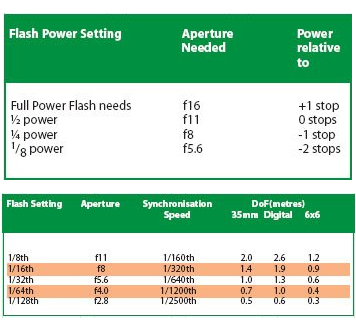articles/Lighting/fillinflash-page2
Fill In Flash - part 2 of 1 2
by Tom Lee Published 01/08/2004

Note that regardless of what you do, you are stuck with an aperture of at least f11 and you cannot reduce your depth of field any lower (by opening the aperture) because you cannot make the shutter speed any faster. If you have unlimited flash synchronisation speeds then you can pick from the table below and always keep your flash at ¼ of the ambient level. The table summarises the options for standard lenses at 3m.
There are two noteworthy things about the analysis above. Firstly, if you use a zoom lens with a constant aperture you can keep your flash fill ratios identical and as you build a group of formals you simply zoom out to increase your field of view. It is better to keep your flash auto zoom at the widest setting and put up with the lower output. As you can see, at 1/128th there is tons of spare anyway! The other thing is that you need a way of getting your flash synchronisation speed up from the standard 1/160th of a second - read on.Flash 1 example
HSS - High Speed Synchronisation
In spite of what the advertising hype may have us believe, this is a technology which came in with the Olympus OM3Ti. With a focal plane SLR the faster shutter speeds are "created" by reducing the gap between the first and second shutter blinds to such an extent that a slit traverses across the film gate. This leads to the complete blocking of the light for part of the image. However, if the flash duration is extended so that it is firing all the time at the same intensity then the film gate receives equal intensity across its height. This is achieved by making the flash fire as a strobe at about 50 flashes persecond. In order to do this the flash intensity has to be reduced so that the capacitor can keep up. This loss amounts to about a halving of the guide number for each 4-fold shutter speed increase (see table below). It is not really a problem as once again we were always likely to be using our flash at somethinglike 1/8th to 1/64th power anyway. Most of the major camera manufacturers can provide a flash with this facility as can specialist gun maker Metz.
stop from the ambient reading (thus ensuring that the bright highlights on a white satin are not clipped) and add back a controlled amount of flash to bring the shadows up to a more acceptable level. It isquite unrealistic to think about pegging exposures to 5 RGB points in the heat of a wedding shoot. However you must know enough about how your camera behaves to guarantee that you never clip the highlights because, regardless of how good your Photoshop skills are, you can never recover clipped detail. The bare minimum that you can do is turn on the clipping flasher (should you have one) and also keep an eye on your histogram.
Tom Lee FSWPP
SWPP & BPPA Vice President,Tom Lee, is an experienced Metz
Mecablitz 70 user so we sought out his views on its performance in the field.Tom sets up at -0.5 EV on his Fuji S2 ambient TTL metering and then sets the TTL flash of the Metz at -1.5EV or -2EV.These are his basic settings which he will tweak when the subject calls for it for example a heavily back lit bride in strong sun may even require the flash and ambient exposures to match 1:1 - although he still keep about half a stop of under exposure to ensure that his maximum highlight is pegged to about 240RGB points.Flash example 3
Coming Soon
Such is the importance that we attach to the matters discussed in this feature that we plan to extend it to describe the way other leading members of the Society control their flash and contrast ratios. Aled Oldfield uses the Metz 45 because he likes the simple mechanical dial on the top, but has also experimented with video tungsten lighting for contrast control. Jonathan Brooks has experimented with the Lumidyne off camera, portable flash systems.We also hope to take a close look at the high speed flash synchronisation options from flash manufacturers.
Please Note:
There is more than one page for this Article.
You are currently on page 2 Contact Tom Lee
1st Published 01/08/2004
last update 09/12/2022 14:54:13
More Lighting Articles
There are 0 days to get ready for The Society of Photographers Convention and Trade Show at The Novotel London West, Hammersmith ...
which starts on Wednesday 15th January 2025





